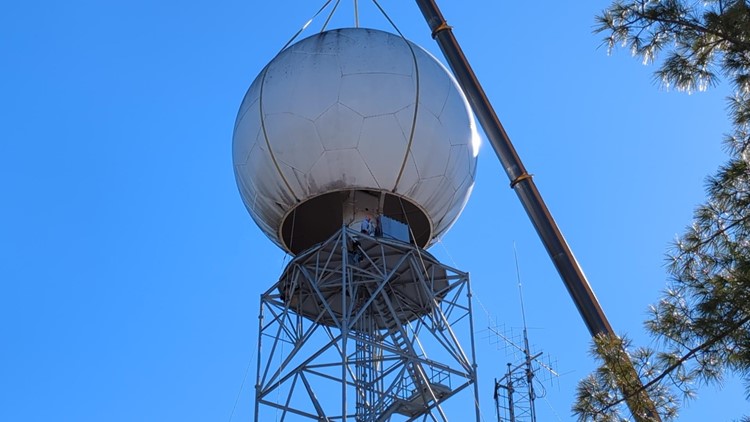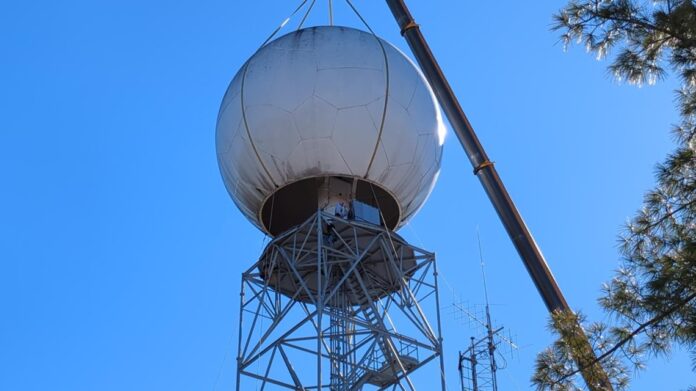
While some radar coverage is present in Charlotte, the signal isn’t ideal, allowing dangerous events like tornadoes to literally slip under the radar.
CHARLOTTE, N.C. — A new bill introduced in the House of Representatives seeks to update the National Weather Service‘s aging radar systems and eliminate coverage gaps across the United States.
The legislation, sponsored by Rep. Tim Moore of North Carolina, would establish a “Radar Next Program” to replace the current Next Generation Weather Radar (NEXRAD) system with more advanced technology. It’s not the first time such legislation has been pushed. Attorney General Jeff Jackson filed a similar measure while he was in Congress in 2023.
“The devastation of Hurricane Helene showed us just how important accurate weather data is to saving lives and hardening communities to minimize damage from upcoming storms and natural disasters,” Moore said. “Charlotte is one of the most populated regions in the country without full radar coverage, creating a blind spot that puts families at risk and hampers emergency response. I’m proud to lead the Radar Gap Elimination Act to close these critical gaps by prioritizing new radar in underserved areas and transitioning to new technology that can better detect severe weather.”
Under the bill, the National Oceanic and Atmospheric Administration (NOAA) would develop performance requirements for a modern weather radar network covering both the mainland United States and its territories.
The proposal calls for NOAA to create a comprehensive plan that would:
- Estimate improvements in radar performance, coverage and accuracy
- Develop a proof-of-concept phased array radar system
- Establish a weather surveillance radar testbed to evaluate commercial options
- Seek input from meteorologists, emergency managers, and public safety officials
“The plan developed under this subsection shall seek to continue and improve weather radar coverage in the United States and its territories,” the bill states.
Charlotte’s ‘radar hole’
Charlotte suffers from what WCNC Weather Impact Chief Meteorologist Brad Panovich calls a “radar hole.” While some radar coverage is present, the signal isn’t ideal for places like Charlotte, Monroe, Concord, Statesville and Hickory. As a result, certain weather events, including tornadoes, can literally slip “under the radar.” That’s what happened when four people were injured by an EF-2 tornado in Harrisburg, North Carolina in 2012.
A key provision aims to address areas currently underserved by radar coverage, specifically targeting locations more than 75 miles from existing NEXRAD stations. That includes Charlotte. The nearest radar to Charlotte is located in Greer, South Carolina, approximately 80 miles from Uptown Charlotte. Other radars in the Carolinas that are slightly farther away include Columbia and Raleigh, as well as Blacksburg, Virginia.
After dangerous winds killed 37 people and injured 20 others in a Charlotte plane crash in 1994, Charlotte Douglas International Airport was awarded a “terminal doppler radar.” “TCLT,” as it’s known, is in northwest Charlotte and monitors the weather surrounding the airport. The radar is operated by the Federal Aviation Administration and not the National Weather Service.
The legislation also allows NOAA to partner with outside entities to “fill data gaps in weather radar coverage” and “better detect significant precipitation and severe weather over a greater area across a population.”
These partnerships could include entities that have participated in radar testing programs, the National Mesonet Program, or Cooperative Research and Development Agreements.
Weather camera systems, in consultation with the Federal Aviation Administration, are specifically mentioned as potential supplementary technologies.
The bill sets a deadline of September 30, 2040, for full implementation of the radar modernization plan.
If passed, NOAA would be required to provide regular updates to the House Committee on Science, Space, and Technology and the Senate Committee on Commerce, Science, and Transportation on the program’s progress.



